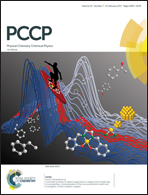Vibrational frequencies and spectroscopic constants of three, stable noble gas molecules: NeCCH+, ArCCH+, and ArCN+
Abstract
The search for possible, natural, noble gas molecules has led to quantum chemical, spectroscopic analysis of NeCCH+, ArCCH+, and ArCN+. Each of these systems has been previously shown to be a stable minimum on its respective potential energy surface. However, no spectroscopic data are available for laboratory detection or interstellar observation of these species, and the interstellar medium may be the most likely place in nature where these noble gas cations are found. The bent shape of NeCCH+ is confirmed here with a fairly large dipole moment and a bright C–H stretching frequency at 3101.9 cm−1. Even if this molecule is somewhat unstable, it is likely observable now that the spectral ranges of where to look have been established. ArCCH+ is much more stable but has dim double harmonic intensities for the vibrational fundamentals and a dipole moment below 0.5 D making its rotational transitions likely buried in the astronomical weeds. Even so, ArCCH+ cannot be excluded as a possibility in laboratory experiments of hydrocarbons in argon-rich environments. ArCN+, on the other hand, has a dipole moment of greater than 3.5 D, an observable C–N stretching fundamental at 2189.6 cm−1 (4.567 microns), and a viable formation pathway through HCN, a highly-abundant interstellar molecule. Consequently, these molecules containing noble gas atoms are spectroscopically classified at high-level for the first time and may be present in observable regions of outer space.



 Please wait while we load your content...
Please wait while we load your content...